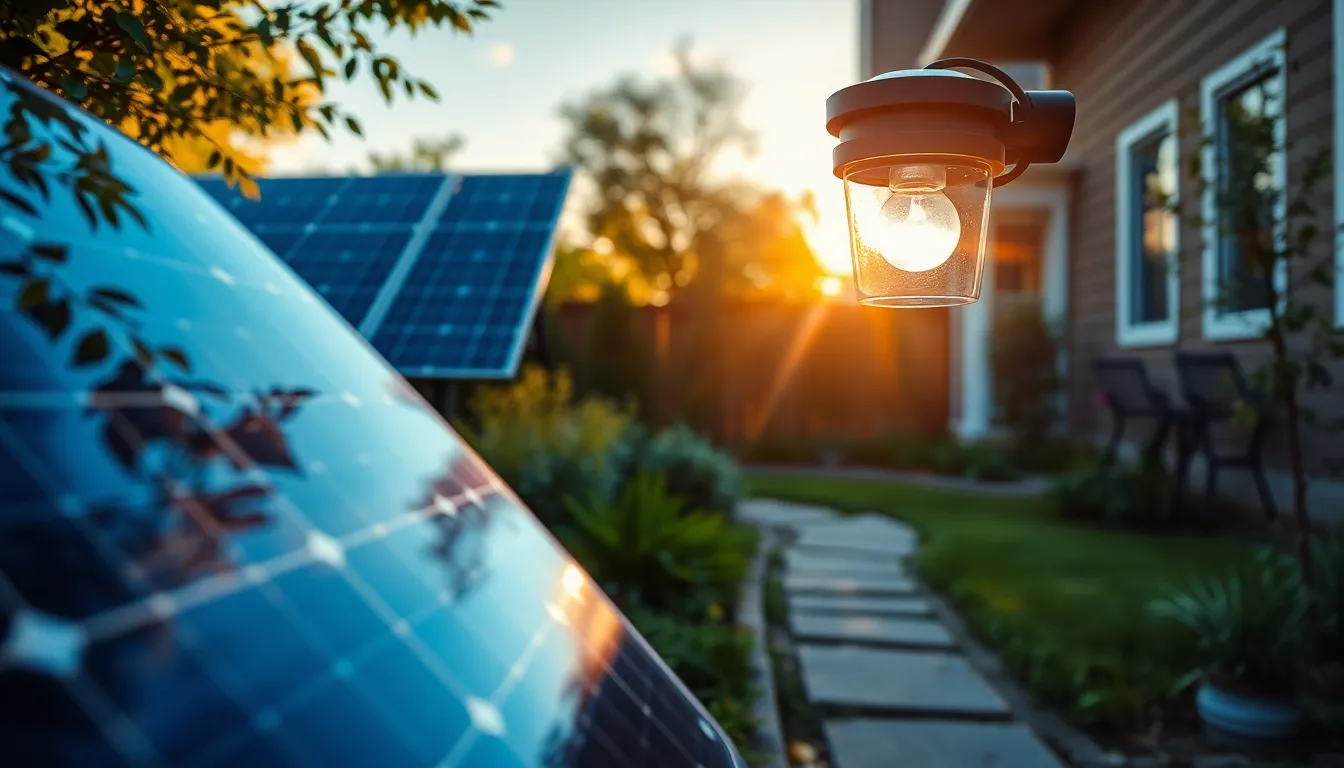As the sun sets and darkness falls, outdoor spaces can transform into enchanting retreats. Solar-powered outdoor lights offer a sustainable solution to illuminate gardens, pathways, and patios without racking up electricity bills. These eco-friendly fixtures harness the sun’s energy, providing a cost-effective way to enhance safety and aesthetics in any outdoor setting.
With advancements in technology, solar lights have become more efficient and versatile than ever. They come in various styles and designs, catering to different tastes and needs. Whether it’s for ambiance or security, solar-powered lights not only brighten up the night but also contribute to a greener planet. Embracing this innovative lighting option is a step toward sustainable living while enjoying the beauty of outdoor spaces after dark.
Table of Contents
ToggleOverview of Solar-Powered Outdoor Lights
Solar-powered outdoor lights offer an efficient and environmentally friendly solution for outdoor illumination. Their popularity stems from a combination of functionality, aesthetics, and sustainability.
Benefits of Solar-Powered Lighting
- Cost-Effective: Solar-powered lights eliminate electricity costs by harnessing sunlight, leading to significant savings on energy bills.
- Eco-Friendly: They rely on renewable energy, reducing carbon footprints and contributing to sustainable living practices.
- Easy Installation: Most solar lights require no wiring or professional installation, allowing for quick setup in various outdoor spaces.
- Portability: Solar lights are easily movable, adapting to seasonal changes or landscaping modifications.
- Low Maintenance: With no bulbs to replace frequently and durable designs, these lights need minimal upkeep.
- Enhanced Safety: Illuminating pathways and driveways increases visibility, reducing accidents and enhancing security.
Popular Types of Solar-Powered Outdoor Lights
- Solar Pathway Lights: These lights line walkways, providing safe navigation and aesthetic appeal in gardens and yards.
- Solar Flood Lights: Ideal for illuminating large areas like patios or driveways, offering bright light and added security.
- Solar Spotlights: Used to highlight landscaping features or architectural elements, providing focused lighting.
- Solar String Lights: Perfect for creating ambiance, these lights can transform outdoor spaces into charming retreats.
- Solar Wall Lights: Mounted on walls or fences, they provide additional lighting for entrances and outdoor seating areas.
- Solar Lanterns: Versatile for table settings or hanging, these lights offer a warm glow while enhancing outdoor charm.
How Solar-Powered Outdoor Lights Work

Solar-powered outdoor lights function by converting sunlight into electricity, providing a sustainable lighting solution. The process involves several key components, including solar panels, batteries, and lighting fixtures.
The Solar Panel Mechanism
Solar panels consist of photovoltaic cells that absorb sunlight. When sunlight hits these cells, it generates direct current (DC) electricity. The efficiency of solar panels typically ranges from 15% to 20%, depending on the type and quality of the panels. This electricity powers the lights during the evening hours. Solar panels can fully recharge within 6 to 8 hours of direct sunlight, ensuring reliable lighting after dark.
Battery Storage and Usage
Batteries store the electricity generated by solar panels for later use. Common battery types include lithium-ion and lead-acid, both known for their performance and longevity. Typically, batteries can hold enough charge to allow lights to operate for 8 to 12 hours, depending on the design and energy demands. Charge controllers manage the flow of electricity, preventing overcharging and extending battery lifespan. Effective battery management contributes to the overall efficiency of solar-powered outdoor lighting systems.
Factors to Consider When Choosing Solar-Powered Outdoor Lights
Selecting the right solar-powered outdoor lights involves key considerations that ensure functionality and aesthetic appeal in outdoor spaces. Two critical factors include brightness and durability.
Brightness and Lumens
Brightness measures the light output of solar-powered outdoor lights, indicated in lumens. Higher lumen ratings correspond to brighter lights, which enhance visibility. For pathways, lights with 100 to 200 lumens create adequate illumination. For security purposes, choose lights exceeding 300 lumens. Understanding the desired brightness level based on specific needs helps in selecting the appropriate solar lights.
Durability and Weather Resistance
Durability reflects the material quality and construction of solar lights, impacting their performance over time. Weather resistance ensures functionality in various outdoor conditions, including rain, snow, and extreme temperatures. Look for lights rated with an IP65 or higher for water and dust resistance. Materials like stainless steel and strong plastics enhance longevity, preventing deterioration and ensuring reliable outdoor lighting throughout the seasons.
Installation and Maintenance Tips
Proper installation and regular maintenance enhance the efficiency and lifespan of solar-powered outdoor lights. Following a few straightforward steps ensures optimal performance.
Easy Installation Steps
- Choose the Location: Select a spot with maximum sunlight exposure throughout the day. Avoid shaded areas from trees or buildings.
- Prepare the Ground: Clear the installation area of obstacles, ensuring a flat surface for stable placement.
- Install the Mounting Hardware: If applicable, install brackets or stakes firmly into the ground or on walls according to product specifications.
- Connect the Solar Panel: For lights with separate solar panels, ensure proper alignment for sunlight exposure, then securely attach the panel.
- Position the Light Fixture: Place the light fixture in the desired location, adjusting angles for optimal lighting coverage.
- Activate the Light: Turn the light on, usually by pressing a button or switching it to “On” mode, and allow it to charge under sunlight.
Caring for Your Solar-Powered Lights
- Regular Cleaning: Clean solar panels every few months with a damp cloth to remove dirt and debris, ensuring maximum sunlight absorption.
- Inspect Components: Periodically check for wear and tear. Inspect the light fixture, solar panel, and batteries for any damage.
- Adjust the Position: Reassess the positioning of lights seasonally as trees grow or landscaping changes could cast new shadows.
- Replace Batteries: Change batteries as needed. Regular replacements every one to two years maintain functionality and efficiency.
- Secure Connections: Ensure all wiring and connections remain tight and free of corrosion to prevent power loss.
- Store During Extreme Weather: For extreme conditions, detach and store lights indoors to protect components and prolong lifespan.
Solar-powered outdoor lights represent a smart choice for anyone looking to enhance their outdoor spaces. They combine sustainability with style and practicality. By opting for these eco-friendly lighting solutions, individuals can enjoy beautifully illuminated gardens and pathways while also reducing their carbon footprint.
With a variety of designs available, there’s a perfect option for every outdoor setting. The ease of installation and low maintenance requirements make solar lights an attractive alternative to traditional lighting. As technology continues to improve, the efficiency and reliability of these systems will only get better.
Embracing solar-powered lights not only transforms outdoor areas but also contributes to a greener environment. It’s a win-win for homeowners and the planet alike.




